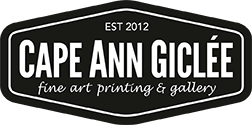Whether you have had prints made on paper canvas or another form of print media it is important to know how to care for these prints.
Photo by Dimitri Baglaneas on luster photopaper

For paper prints:
Remove all tape that was used for packaging. Even the smallest piece can find its way to your print and damage the surface.
Handle the print only by the edges, preferably with clean white cotton gloves. The oils from you hands can affect the PH of the paper and reduce the archival qualities. Fingerprints on dark areas will show up as sheen.
Use two hands to support the print, so it will not bend. A crease in the print is permanent.
Do not use your hands to wipe off any dust, this can scratch the surface. Use canned air gently and always keep the can upright so no Freon comes out.
Be gentle. Some of the fine art papers we use are a fibrous media. if you rub your print, it will pill, and the ink on the surface can scratch off. This applies to both glossy and matte/watercolor prints.
Keep moisture or condensation from getting on the print. Although the ink is somewhat water resistant, water can still cause damage. A water drop on the print surface will be permanently visible when dry.
If possible, allow a few days for your print to breathe before framing so the inks can completely set and any outgassing can escape. Make sure that when the print is framed that natural expansion and contraction is taken into account – if you are taping a print to a mat board do not tape all around the print as this may cause ripples in more humid weather as the print tries to expand and cannot – instead use a hinging method or have a professional framer do the job.
When framing, use only archival (acid-free) supplies. Wood frames treated with chemicals or paints can omit harmful gases that can attack the ink and paper.
DO NOT USE the cardboard materials we package our jobs in or the cardboard tubes for long-time storage of your fine art print, they are NOT archival. However, the clear plastic sleeves we use are archival. Tubes and hard envelopes can be reused and/or recycled.
Use common sense–storing or exhibiting a print in bright sunlight, or in a setting that might have chemical outgassing (from freshly painted walls, new rugs, and other fumes) which may cause fading or discoloration.
canvas giclee print of Artist Ron Pruett’s original work

For canvas prints:
For canvas that has been stretched on wooden stretcher bars, changes in relative humidity and temperature can cause sagging or rippling. Ideal environmental conditions are 70 degrees and 55% humidity. You may notice that in the winter your canvas may be a bit saggy – especially during a time of cold dry weather when the air is dry and the heat has been on. You can mist the back of your canvas with water – do not saturate the print or wood just a gentle mist – usually that is all that it takes. The stretcher bars are made from wood and it is natural for them to expand and contract. If the light misting does not work corner keys inserted to the corners of the canvas will do the trick.
Clean your canvas giclee print with a dry, lint free cloth. Never use a wet or moist cloth to clean your giclée canvas pint. DO NOT wash printed surfaces with water or solvents and make sure the cloth is clean. Avoid touching the canvas surface with bare hands as the oils in your skin can leave marks – we recommend wearing cotton gloves to handle all artwork.
Lighting: It is recommended that you DO NOT keep your giclée prints in direct sunlight.
Storage: Please store your final canvas in an environment controlled for both humidity and temperature. Ideal environmental conditions are 70 degrees and 55% humidity. High humidity can cause yellowing. Keep all giclée prints away from solvent-based materials such as oil paints and linseed oil, as the vapors can cause yellowing. Stretched pieces should be stored upright, not stacked and all prints should be interleaved with archival paper dividers and never stored with any weight on top of them. Avoid tape coming in contact with the coated print as it can peel. Do not store canvas in cardboard – use the archival clear bags that your canvas came in.
